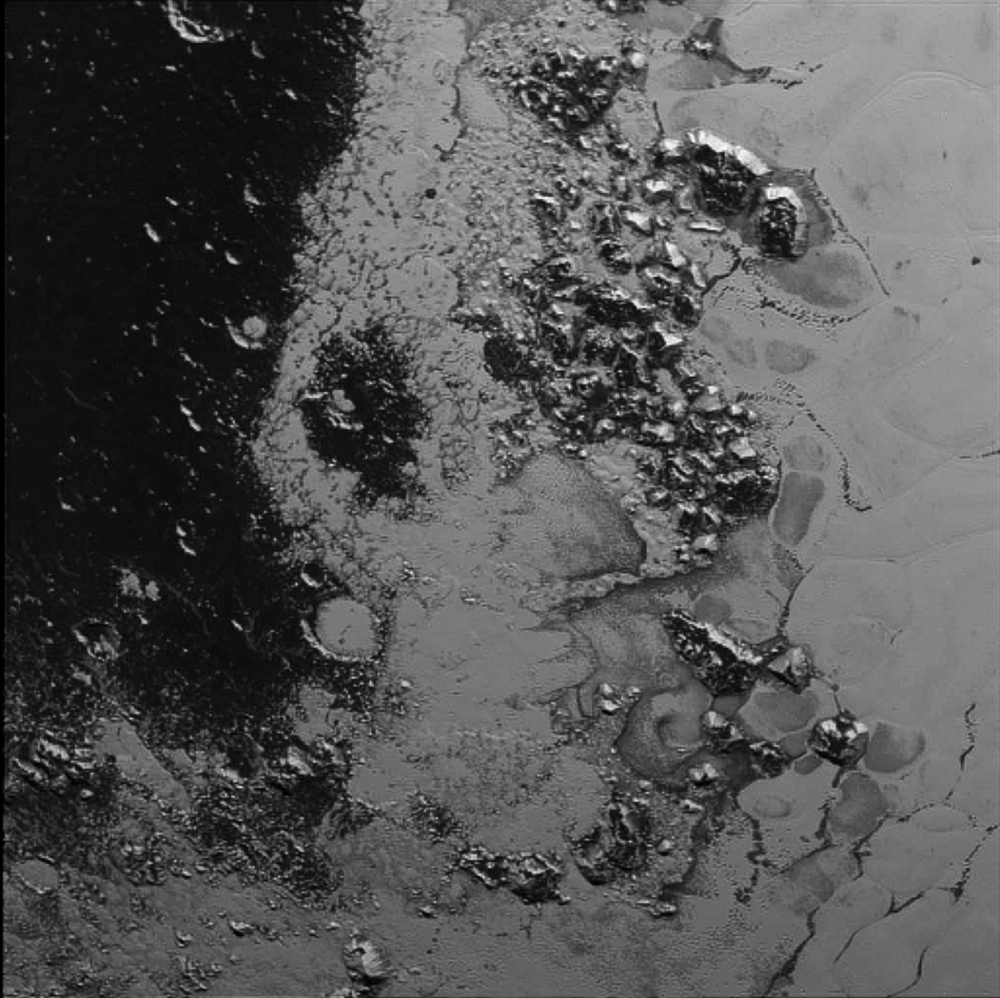The images from the New Horizons flyby of Pluto last week are spectacular. Mountains 11,000 feet high. Vast, frozen white plains. On the moon Charon, a surprising lack of craters, and a chasm five or six miles deep that looks, in the picture, like a chip out of a planet.
This all comes to us from 3 billion miles away, 9½ years after the spacecraft was launched. What have we learned? Well, it will take years to figure that out. The information that’s beaming back in photos and instrument detections of Pluto’s surface and its unexpectedly deep atmosphere, has to be sorted, organized and interpreted. Not only that, but New Horizons is now drilling through space out past Pluto into the Kuiper Belt, from where, it is hoped, more information will percolate Earth-ward for five more years, if all goes well. Lots of scientific work to do.
There is a glow of inspiration about all this, even for millions of us who aren’t planetary scientists. And there are also people wondering why all that time and money went into sending a robot to what is for all intents and purposes nowhere, to do nothing that will solve any of Earth’s worst problems.
Well, you’re in luck, because I can tell you one critical reason why.
By the time it’s over, the New Horizons mission will have cost about $700 million. This is money that could have been spent on caring for the needy, or medical research, or food programs. These are all essential, bewilderingly underfunded missions, no doubt about it.
But in our time, we have a tendency to ignore, or evade, or radically misconstrue a fact of human nature: The inner, psychological needs of humans are as important as the material needs.
In reality, physical well-being and psychic well-being form a sort of yin and yang partnership in us. The body requires nourishment — which includes obvious needs such as food and medicine — and the mind requires nourishment. Maybe we are not so clear on what the mind’s nourishment really is. In fact, I know we’re not very clear on it.
By “mind” I mean the inner being which is your conscious, everyday life — the world of thought, emotion, moral disposition, imagination, intuition, and whatever else, conscious or unconscious, activates and colors your awareness and experience. The word “spirit” comes to mind, if you want to use it. This complex of inner experience can be healthy or unhealthy the same way the body can be healthy or unhealthy. Well-nourished or malnourished. Which comes first, a healthy mind, or a healthy body? It’s hard to say, because they feed — or starve — each other.
Schools nourish the intellect. But less and less, with the shrinking and cancellation of arts and music programs, do they cultivate the faculties that are as alive in your mind as thinking.
If thoughts don’t get the right exercise, they get unhealthy. The same is true of emotions. And of moral maturity, of intuitive and aesthetic sensibilities, and — emphatically — of the imagination. Books, movies, artwork, architecture, religious activities, even newspapers, are sparks for the imagination more profoundly than they are conveyors of information. They light little fires that can be used to cook up ideas, entertainments, understanding, relationships — they are nourishment for the mind.
Now, I’m pretty sure, after paying attention to this for decades, that the vast majority of people have gotten many of their most high-voltage charges of imagination from looking at the stars. The night sky is the most awesome, most immanent, alluring, inspiring, immediate connection we have to the enormous unknown of the cosmos.
Since time immemorial, humans have set about to find out where we are and what our relationship to it is, and the starting point is curiosity about our physical surroundings. Who first went down into the Chauvet caves in France 35,000 or more years ago, and why? They went because they wondered what they might find there and how they might be able to use it. It turned out some kind of power was down there that they transformed into astonishing paintings, and who knows what else that fostered their well-being for thousands of years.
Up here in modern times, if Galileo, Kepler, Copernicus and their many associates in science, philosophy and art had neglected that same imaginative curiosity 400 years ago, we wouldn’t even be having this conversation. We wouldn’t know Pluto even exists, and many of us wouldn’t even be here. The medicine would not have been devised to keep many of us, and many of our ancestors, alive.
The unknown fires the imagination. The imagination is one of the keys to mental and physical health. In the 21st century, the most imagination-firing public activity we engage in is the exploration of the stars.
Visiting distant planets — even by robot — is a fundamental nourishment of the mind in which we all feel like participants. In truth, it’s something we can’t live without. Space exploration is critical to our well-being. It’s probably the most powerful tangible action a government can take, apart from schools, to actively nourish the mind of people who, in many ways, for many reasons, are nearly famished.
What’s down there in the caves and chasms of Charon?
Dana Wilde lives in Troy. He is a contributor to “Pluto: New Horizons for a Lost Horizon” available from North Atlantic Books. You can contact him at naturalist1@dwildepress.net. Backyard Naturalist appears the second and fourth Thursdays each month.
Send questions/comments to the editors.



Comments are no longer available on this story